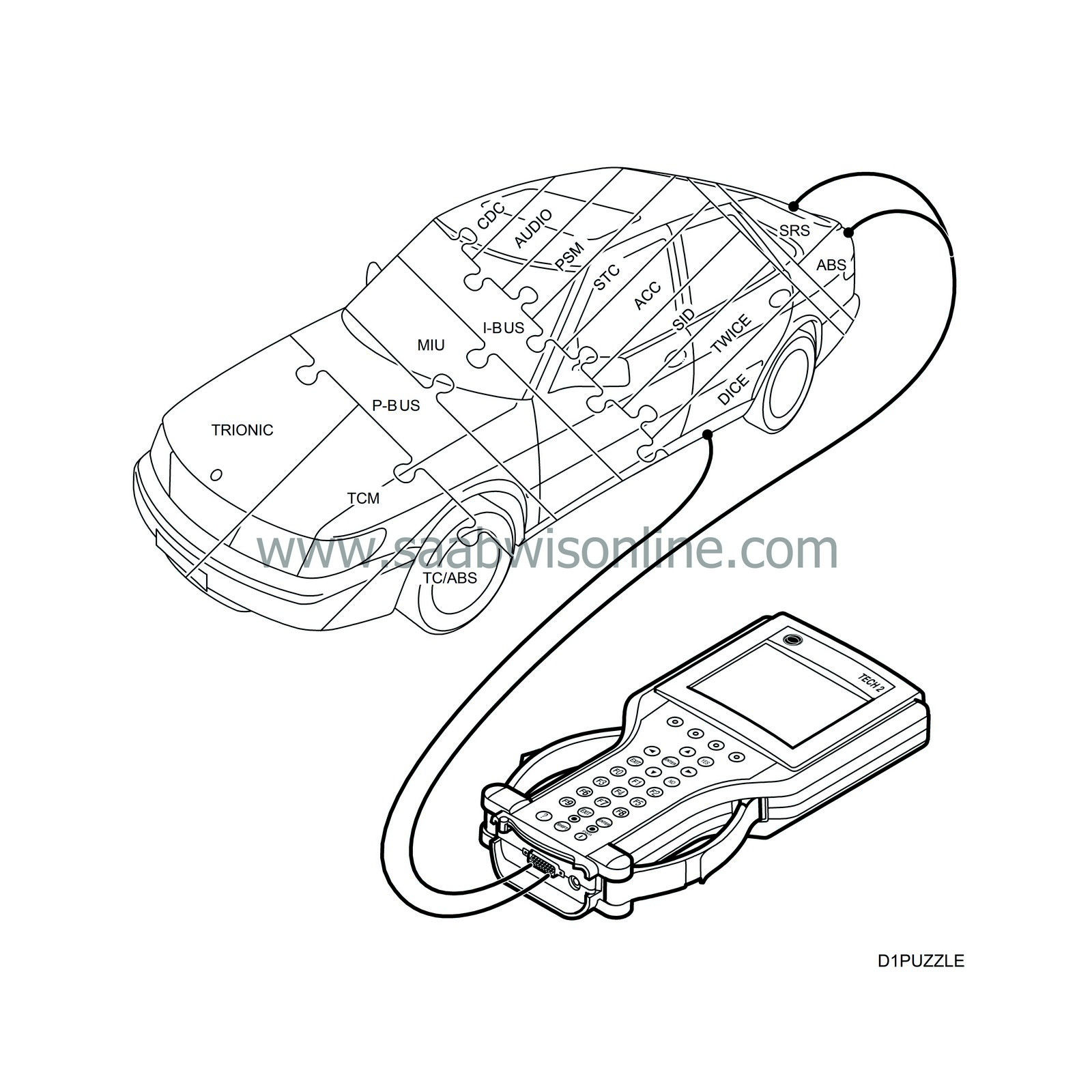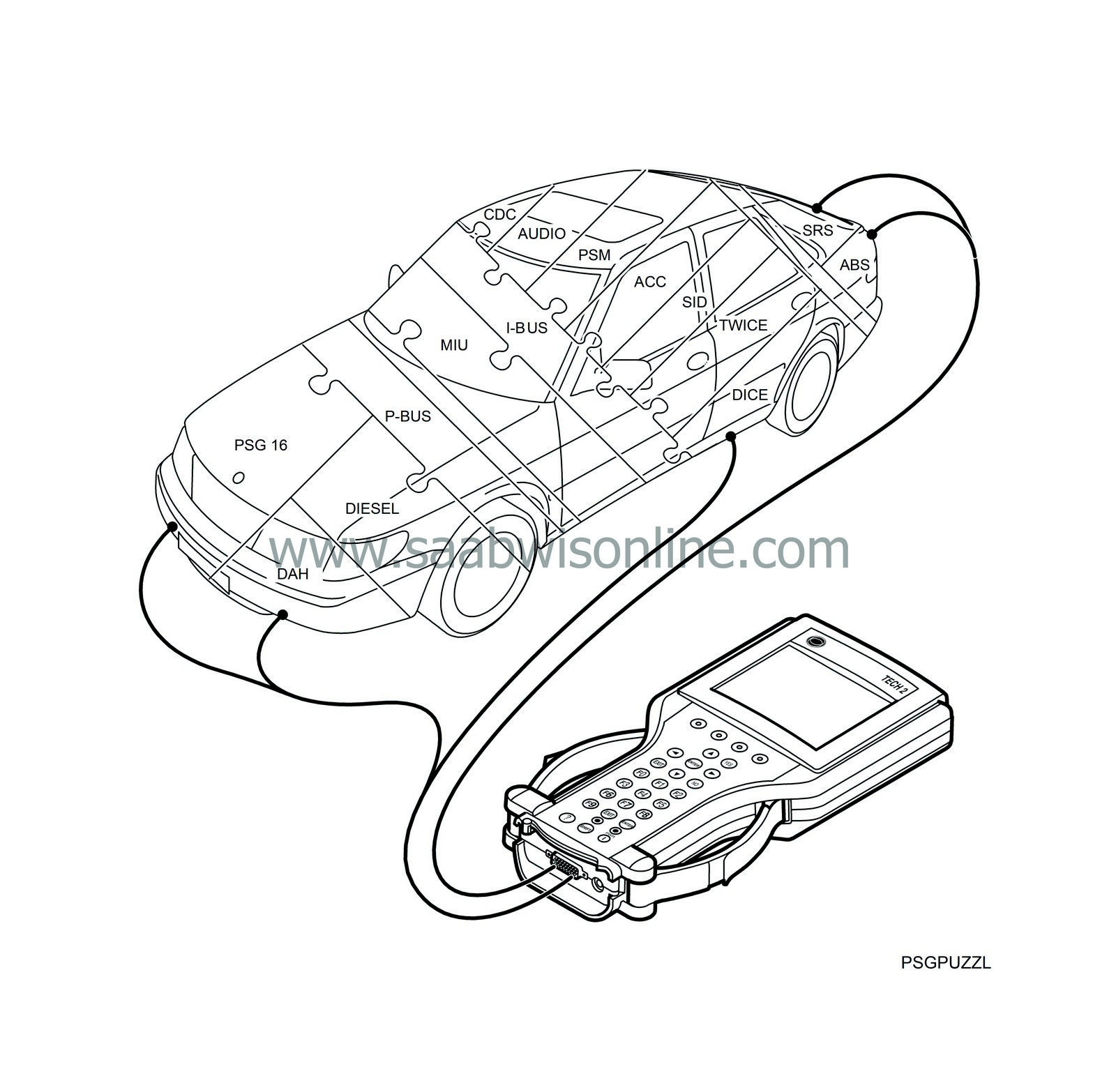Brief description, anti-theft alarm
| Brief description, anti-theft alarm |
| General |
The theft protection of the car consists of two functions, immobilizer which is standard on all cars except cars with OBDII which has a simpler form of so called start interlock and theft alarm as an option. The theft protection functions are controlled by TWICE.
| Immobilization |
The immobiliser prevents the car starting if the wrong key is used. The fuel supply is shut off and the starter motor relay blocked. The car key contains a transponder with a unique identification code which is received by a receiver unit. The receiver is located in the ignition lock.
The receiver that is connected to TWICE sends the code to TWICE, which is programmed to recognise the car keys. If the correct key is inserted in the ignition switch (ignition position ON), the engine can be started. If a faulty transponder or one which does not belong to the car is used, “KEY NOT ACCEPTED” will appear on the SID display.
In the event of a fault in the receiver unit or the transponder, the car key can be used to mobilize the car instead. The car will be mobilized if a button on the remote control is pressed after turning the ignition to the ON position.
| Anti-theft alarm |
The anti-theft alarm can be factory-fitted or installed as an accessory.
The anti-theft alarm is armed/disarmed using the car key. On the US/CA/LA markets, the alarm can also be armed/disarmed using the key in the driver's door or the boot lid/tailgate (disarming). If the anti-theft alarm is armed and the car key is inserted into the ignition and turned, the anti-theft alarm will be disarmed when the correct identification code is received from the transponder.
The anti-theft alarm has the following inputs for tripping the alarm:
| • |
Door switches
|
|
| • |
Luggage compartment switch
|
|
| • |
Bonnet switch
|
|
| • |
Ignition lock (position ON with incorrect key)
|
|
| • |
Glass breakage sensor
|
|
| • |
Angle sensor (accessory)
|
|
A tripped alarm is indicated by:
| • |
Direction indicators
|
|
| • |
Siren
|
|
The behaviour of the anti-theft alarm depends on the market.
Door switches
The door switches are mounted in the frame of the door concerned and grounded through the switch mounting screw to the bodywork. The switches are supplied with a pulse width-modulated (approx. 3.5%) voltage via a 1 kohm pull-up in TWICE. When a door is opened, the switch is closed and the control module input is grounded.TWICE sends out information on the door position to the bus, where it is used by DICE for example for interior lighting. The anti-theft alarm also uses the door switch.
Luggage compartment switch
The luggage compartment switch is fitted in the tailgate lock. The switch is supplied with a pulse width-modulated (approx. 3.5%) voltage via a 1 kohm pull-up in TWICE. When the tailgate is opened, the switch is closed and the control module input is grounded.TWICE sends out information on the tailgate position to the bus, where it is used by DICE for example for the luggage compartment lighting. The anti-theft alarm also uses the switch.
Key switch, luggage compartment disarm
The key switch is located by the luggage compartment lock and is grounded through contact with the body. The switch is powered by a pulse width modulated (approx. 3.5%) voltage via a 1 kohm pull-up in TWICE. When the key is turned in the lock, the switch will close and ground the control module input. The luggage compartment is then disarmed.Bonnet switch
The bonnet switch is placed at the rear left of the engine bay. The switch is supplied with a pulse width-modulated (approx. 3.5%) voltage via a 1 kohm pull-up in TWICE. When the bonnet is opened, the switch is closed and the control module input is grounded.TWICE uses the bonnet switch to trip the anti-theft alarm if the bonnet is opened when the alarm is armed.
Glass breakage sensor
The glass breakage sensor is located in the rear roof lamp (on the interior rear-view mirror on the Cabriolet) and is powered from TWICE.The glass breakage sensor reacts to the sound of breaking glass. The sensor is of the active type and makes its own assessment and decision on whether the glass has been broken.
It is possible to disconnect the sensor by pressing the NIGHT PANEL button on SID while the car key is not in the ignition switch. The glass breakage sensor is automatically disconnected on convertible models when the top is lowered.
Angle sensor
The angle sensor is located in the centre console rear section and is powered from TWICE.The sensor reacts to the car's angle and sets off the alarm if the car is raised on one side, just before the wheel is lifted off the ground.
It does not react for example if the car is buffeted by a strong wind. The sensor should however be disconnected if the car is to be transported on a ship as the anti-theft alarm can be tripped.
It is possible to disconnect the sensor by pressing the NIGHT PANEL button on SID while the car key is not in the ignition switch.
Siren
The siren unit is located at the rear edge of the left-hand front wheel housing. It has two piezo-electric sirens and is equipped with back-up batteries so that it will sound even if the ordinary car battery is disconnected or dead, or if somebody cuts the leads to the siren unit.Direction indicators
The car's direction indicators are activated via bus information from TWICE which DICE uses to turn on the direction indicators.LED (Light Emitting Diode)
The light emitting diode is located on top of the dashboard and is supplied with power from TWICE. (Only cars with theft protection have an LED.)The LED is used to indicate the status of the anti-theft alarm:
| - |
A double flash means that the car is immobilised.
|
|
| - |
A flash every 3 seconds means that the anti-theft alarm is armed.
|
|
| - |
A fast flash during the delay time means that a door or the bonnet or tailgate is open.
|
|
| - |
A continuous light during the delay time means that everything is OK.
|
|
| Car key with integrated remote control |
The car key is used to operate the car's central locking system and to arm and disarm the anti-theft alarm.
The car key has three button with the following functions:
| • |
Lock/arm anti-theft alarm
|
|
| • |
Unlock/disarm anti-theft alarm
|
|
| • |
Unlock tailgate/disarm anti-theft alarm on tailgate
|
|
If a button on the car key is pressed and held down, a code will be sent to the receiver. The receiver is connected to TWICE, which performs the requested command.
| P-bus and I-bus |



All Saab 9-3 M99 are equipped with the Trionic T7 engine management system. The bus system is therefore almost identical to the one fitted on the 9-5.
The bus system on diesel cars with EDC15 and diesel pump is unchanged from M98 1/ and on cars with PSG 16 from M01 1/2.
The two diesel engine systems EDC15/diesel pump and PSG 16 are not connected to the bus however. These systems require considerably faster communication to avoid any noticeable delays, e.g. when EDC or PSG requests a certain amount of fuel for injection.
Therefore, they are connected to a separate bus called the P-bus (Power-train Bus). The data transfer rate on the P-bus is ten times greater than that of the I-bus.
The P-bus is also connected to the MIU (Main Instrument Unit). The MIU is responsible for ensuring that information which is available on one of the buses is also made available on the other bus.


